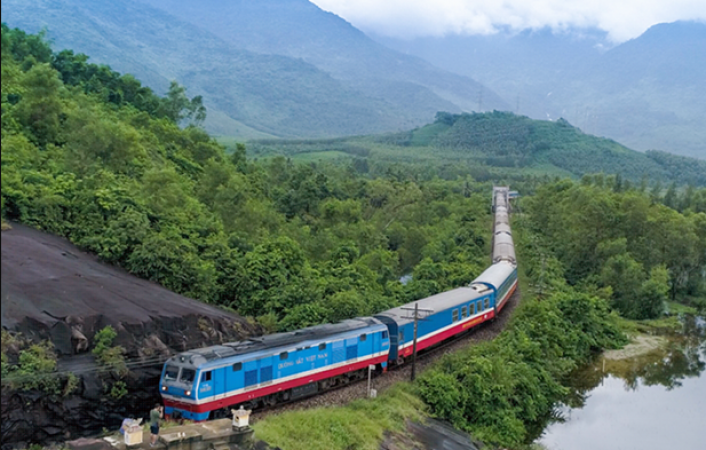
Hanoi: The Vietnamese railway project has been referred to by name in every diplomatic joint statement and declaration between Beijing and Hanoi for the past seven years. However, it has only been conceptualized up to this point.
Last week, during Nguyen Phu Trong's visit to Beijing, the Lao Cai-Hanoi-Haiphong Railway—which runs from the North Vietnamese border to one of the country's largest ports was towed once again.
As part of a larger initiative to improve connectivity, both sides agreed that they would work to expedite the completion of the evaluation of the standard gauge railway project.
Also Read: RBI cancels the license of this bank, check here
David M. Professor Emeritus in the School of Advanced International Studies at Johns Hopkins University. According to Lampton, once built, the route will be part of the Eastern Line of the high-speed railway network connecting Singapore with the Chinese capital Kunming. Southwest Yunnan Province.
According to Lampton, who is also the co-author of River of Iron: Railroads and Chinese Power in Southeast Asia, the first phase of the central line to the border between Thailand and Laos has been in operation since late 2021 with freight and passenger traffic. Traffic is increasing.
Despite Hanoi's concerns about dependence on [China], Lampton, who is also the former chairman of the National Committee on U.S.-China Relations, said that Vietnam should consider opportunities not to engage with this expansion system and its You may miss out on increasing the connectivity together. China only.
There are many reasons for Hanoi to be part of this expanding and developed economic region that includes China and Southeast Asia. ,
The Chinese half of the route was upgraded to 1,435 mm standard gauge in 2014 to accommodate high-speed trains and integrate into China's national rail network, meaning it matches the original 1,000 mm track on the Vietnamese side. Does not eat that was created by the French. At the beginning of the 20th century. As a result, the route is no longer considered essentially a border crossing.
Due to the fact that the shipment must now be unloaded and then reloaded on another train, which reduces efficiency and increases costs, the two sides decided in 2015 to build an international standard gauge for the Vietnamese portion. started researching its feasibility.
Also Read: Yellen: India can purchase Russian oil without regard to price caps
According to a report by the state-run Vietnam News Agency citing the country's Ministry of Transport, China has offered 10 million yuan (US$1.4 million) in aid to assist with surveying Vietnam and creating the first blueprint for the line. Agreed to provide the package.
Preliminary plans for the line, which is expected to be 392 km long (244 mi), have 38 stations, and be able to accommodate both passenger and freight trains, according to a report by the Consultative China Railway Fifth Survey, completed in 2019. it was done. Design Institute Group.
Analysts claim that Vietnamese hesitation has slowed further progress.
According to Lampton, Vietnam is concerned about costs, anti-Chinese sentiment, potential sovereignty violations, broader geopolitical factors and a less than ideal experience with the Chinese-built Hanoi Metro.
According to Choo Minh Thao, deputy director of the Center for Security and Development at the Diplomatic Academic of Vietnam, the Belt and Road Initiative fits well with Vietnam's efforts to promote regional economic connectivity and cooperation, but not the Chinese in Southeast Asia. Infrastructure projects still face some. challenges.
In a previous article, Chu stated that there are many economic, political and social concerns about Vietnam collaborating with China on infrastructure projects.
She continued, "Projects create the impact of delays, low quality and efficiency as well as security concerns about redundancy, and high interest rates for loans from China."
According to Chu, Vietnam is heavily indebted to China in many areas, including electricity, energy and coal power plants, which have polluted the environment and provoked social unrest.
According to Lampton, Nuyen's visit to Beijing was important from a strategic and economic point of view. Vietnam is trying to strike a balance between maintaining its ties with China and attracting outside interests from countries such as the United States and Japan.
Also Read: FTX collapses and files for bankruptcy
Meanwhile, China is concerned about a growing shadow of America's "containment" and wants to secure its southern border by fostering closer ties with Hanoi, according to the analyst.
On a positive note, Beijing is attempting to open new markets overseas to keep up with China's rapid economic growth as domestic demand slows.
And finally, to become one of its future champion industries, China is developing a top-level railroad export industry. Simply put, Beijing wants to be the center of the East and Southeast Asian economic order.